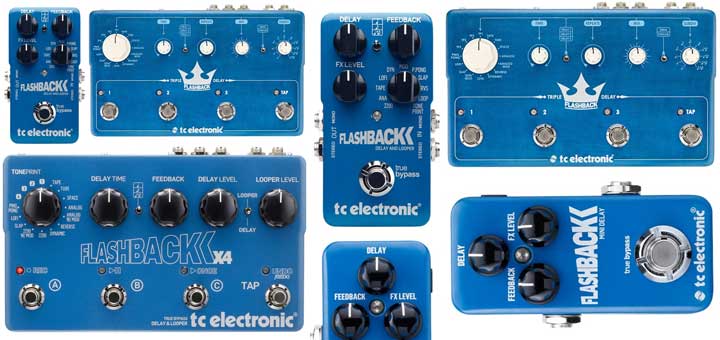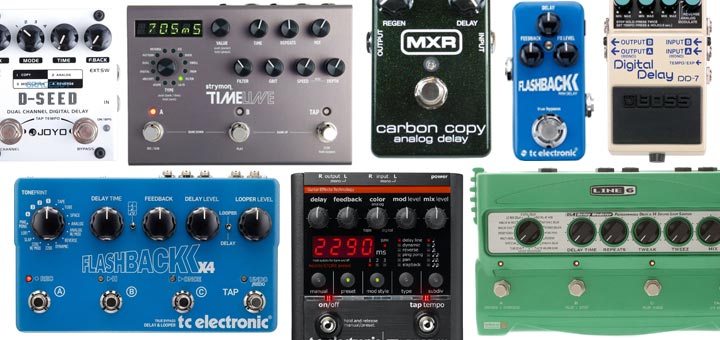If you’ve been playing electric guitar for any length of time and know anything about effects pedals, you have no doubt run into the terms analog delay and digital delay. You may be wondering what the differences are in analog vs. digital delay and which one is a better choice for you.
Update: We published a new definitive guide contains everything you need to know when adding a new chorus pedal to your pedalboards.
How Does It ‘Delay’ Your Sound?
Delay is a guitar effect that records an input signal, then plays it back after a pre-set time delay. This playback can be repeated multiple times to create an echo effect that decays over time.
Delay is one of the most commonly used effects today and is employed in almost all genres of music. It can be subtle where it might be used to create more of a chorus effect to “fatten up” the sound of an individual instrument such as can be heard on B.B. King’s Thrill is Gone; or it might be dramatic, creating “slapback” over other notes to create a complex tapestry of sound such as in Van Halen’s Cathedral or the intro to Guns ‘N’ Roses’ Welcome to the Jungle.
Here is an excellent tutorial on how to employ delay in your sound no matter what style of music you play.
Difference Between Analog And Digital Delay?
While both analog and digital delay both provide an array of similar delay effects, their theory of operation differ significantly.
Analog circuits send the signal along a chain of capacitor chips each one extending time it takes for the signal to reach from one end through to the other. A time or delay control regulates how far down the chain the signal travels before being re-routed the output jack.
A Digital delay accomplishes the same effect through digital signal processing technology. The figures below show a comparison between an analog and digital delay pedal circuits.

Since digital delay pedals use digital signal processing to create their effects, they have greater flexibility so that the sound they produce can be artificially “colored” and the delay times can be as long or short, as the designers choose to make them.
Analog circuits are more limited in what they can do, so the sound tends to be more transparent. Due to the limitations of the capacitor chips, the maximum delay times offered by analog delays are necessarily shorter.
Some High-Rated Delays On The Market?
No matter what your budget is, there are some very good delays on the market. A couple of simple slimline analog models that are highly rated and come in at a very reasonable price are the Donner Yellow Fall Vintage Pure Analog Delay and the Xvive Analog Delay V5.
On the digital delay side, both the Mooer Reecho digital delay pedal and the Valeton Coral Echo Digital Delay offer good performance for the price. The Valeton Coral Echo is truly unique in that it is one of the first pedals to offer digital modeling technology. It offers 11 different types of delay, including emulation of analog delay, so if you are looking for the best of both digital and analog delay, this might be the pedal for you.

If you’d rather stick with the big name traditional manufacturers (and pay name brand prices), the MXR Carbon Copy and Dunlop EP103 Echoplex are both well known and highly respected analog delay pedals used by artists such as Synyster Gates (MXR) and Eddie Van Halen (Dunlop). Among some of the more well-known digital delay pedals are the BOSS DD-7 and the TC Electronic FlashBack.
Which One Is Right For You?

As with any effect you choose, it all has to do with what style of music you play and what your want it to do.
- For blues, jazz, country and classic rock, more of a vintage sound is generally preferred. As such an analog delay will probably provide a truer sound reproduction.
- Much of the surf music and psychedelic rock of the late 60s and early 70s was performed with heavy use of analog delay.
- For metal, grunge and more modern hard rock, digital delay is more appropriate as it provides more flexibility and there’s not as much worry about having a more processed tone.
Of course, eventually, more and more manufacturers will likely enter the race to design modeling delays such as the Valeton Coral Echo, so it might come to the point where you won’t have to choose.
Useful Link: Where should you put the delay pedal on your pedalboard?
Sum It Up!
I hope this article was able to clear up any questions you have about the differences between analog and digital delay and helps you have a clearer direction in your mind if you are currently in the market for a delay pedal. If you enjoyed this article or have any other comments about delay pedals, please feel free to comment.